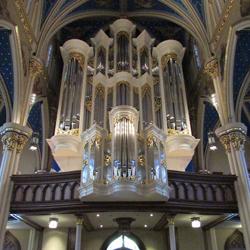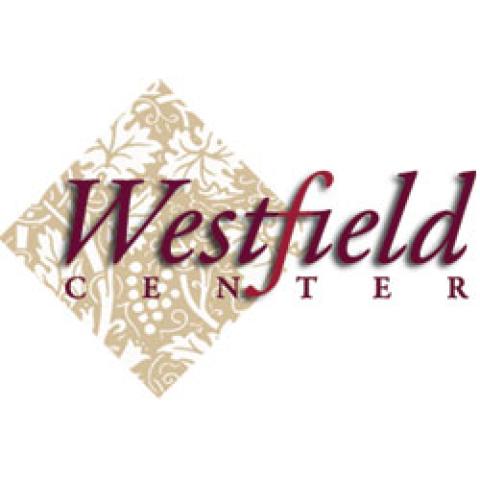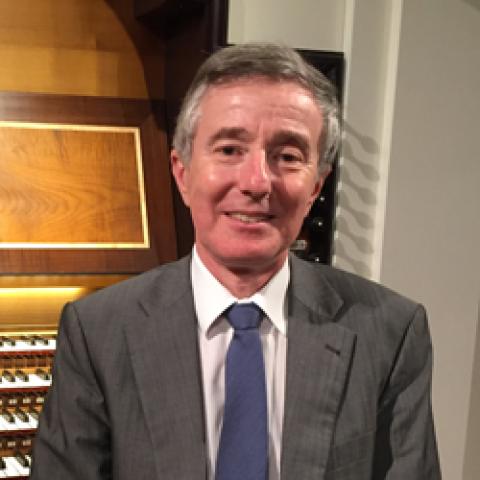Situated on a hill overlooking the city of Lewiston, Maine, the Gothic Basilica of Saints Peter and Paul is visible from a great distance in any direction. Its grand architecture beckons visitors from all over. The interior of the basilica is as sumptuous as its exterior. And among the many treasures of the edifice are the organs.
Lewiston was founded in 1795 along the Androscoggin River. Its industry was supported by cotton mills for many years. By the 1850s the Bates Mill, named for Benjamin E. Bates, for whom Bates College is also named, became the largest employer in Lewiston, remaining so for a century. In the late 1850s, French Canadians began to migrate to Lewiston for job opportunities. A section of Lewiston became known as “Little Canada,” and the city has celebrated its French Canadian character to this day.
Various Protestant congregations were formed, but it would be 1857 before the first Catholic parish, Saint Joseph, was founded. The parish, which was English speaking and serving primarily Irish immigrants, laid the cornerstone for a church along Main Street on June 13, 1864, and finished construction in 1867. The architect was Patrick C. Keely.
The Catholic Bishop of Portland assigned the Reverend Louis Mutsaers to minister to the French-speaking Catholics of Saint Joseph Church. With more than 1,000 souls in the French-speaking Catholic community, Saint Peter Church was founded in 1870, the first French ethnic parish in the diocese. Father Edouard Létourneau of Saint-Hyacinthe, Québec, was named first pastor. The fledgling congregation moved to Saint John Chapel, the second floor of a house on Lincoln Street, coincidentally the first home of Saint Joseph Church. The first Mass, a wedding, was said on July 2, 1870. The Reverend Pierre Hévey became pastor the following year.
The first church
Father Hévey constructed a Gothic church building on Ayers Hill, on Bartlett Street between Ash and College Streets. The cornerstone was laid July 7, 1872, and the edifice was dedicated on May 4, 1873. The substantial building was 116 feet long, 32 feet wide, and crowned by a 160-foot bell tower. The total cost of the building, including land and furnishings, was approximately $100,000. The dedication Mass, attended by 2,000 and presided over by the Bishop of Portland, also witnessed the confirmation of 215 children. The parish school was opened in 1878, and a cemetery was developed. The Sisters of Charity of Saint-Hyacinthe would also establish a hospital, an orphan asylum, and a home for the aged, in addition to teaching in the school. A five-story brick school building accommodating 700 students was opened in 1883 at Lincoln and Chestnut Streets. A second school, for boys, was opened on Bates Street in 1887. By the close of the century, there were 1,721 students in the parish schools.
When Father Hévey left the parish in 1881, administration was turned over to the Dominican Fathers of Lille, France. About this time, Saint Peter became known as Saints Peter and Paul Church. By the late 1890s, church membership neared 10,000 persons, and galleries were added to the church nave, and the building’s basement was enlarged. A brick monastery was built for the Dominicans on Bartlett Street, a building that still stands behind the basilica today. The Dominicans would live here until they returned the parish to the diocese in 1987.
In 1902, Saint Louis Church was founded in Auburn, across the river, but this did little to lessen overcrowding at Saints Peter and Paul Church. In 1904, Father Alexandre Louis Mothon, OP, then pastor of the parish, retained Belgian-native Noël Coumont of Lewiston to design a neo-Gothic edifice to be built of Maine granite at an estimated cost of $250,000. Portland diocesan authorities were duly impressed with Coumont’s work and named him diocesan architect.
Building the present church
The final Mass in the old church was celebrated on February 5, 1905, after which the building was dismantled and demolished. A temporary wooden structure seating 1,200 persons was erected. Adjacent property was acquired, and construction of the lower church was commenced on February 22, 1906. Despite the collapse of a wall on November 9, the lower church was in use for Midnight Mass at Christmas, December 25, 1906. Father Mouthon had resigned and was replaced by the Reverend Antonin Dellaire, OP.
The parish would not complete the upper church for another three decades. In the interim, the diocese created three other parishes in Lewiston: Saint Mary, founded in 1907 in “Little Canada” with 820 families; Holy Family, founded in 1923; and Holy Cross, founded that same year with 575 families.
The diocese granted the Reverend Mannès Marchand, OP, pastor, permission to complete the upper church in 1933. A bid of $361,510 was accepted in April of the following year. Timothy G. O’Connell of Boston had become architect. Construction began in May, and the project would require some 516 boxcars of granite. Slate, copper, and limestone support the roofs.
The exterior was completed in 1935, crowned by twin steeples rising 168 feet with eight spires of granite and concrete. Two fairs would be held in the unfinished interior to raise funds for its completion. The interior was finished on July 18, 1936. The Most Reverend Joseph E. McCarthy, DD, dedicated Saints Peter and Paul Church on October 23, 1938. An all-male choir, recently formed, provided music for the occasion. The total construction price was estimated at $625,000. Five bells, cast for the previous church in 1884 by the McShane foundry of Baltimore, Maryland, were retained for the new towers. In 1948, the magnificent stained glass windows of the nave were installed to the designs of Boston’s Terence O’Duggan, at a cost of $40,000. The building measures 330 feet long, 135 feet wide, and the ceiling rises 64 feet. The pews seat 1,800 persons.
There was considerable posturing to making Saints Peter and Paul the cathedral of the diocese, supplanting Portland’s Cathedral of the Immaculate Conception, founded in 1856 with its church built between 1866 and 1869 to the designs of Patrick C. Keely. Postcards of the Lewiston church were printed and sold, designating it a “cathedral.” However, the move of the seat of the bishop from Portland to Lewiston never occurred.
The building was listed on the National Register of Historic Places on July 14 (Bastille Day), 1983. The second-largest Catholic church in New England, Saints Peter and Paul is exceeded only by Saint Joseph Cathedral of Hartford, Connecticut. In the past two decades, the building has been restored, a heroic multi-million dollar project. The first part of the project, the exterior, took nine years to complete. The interior restoration of the upper church was completed in 2002.
The church’s music history is remarkable. In 1872, a reed organ was acquired, and a Mrs. Martel became organist. Mr. Alcibiad Beique succeeded her. Considered an accomplished organist as he had studied in Belgium, Beique would play the opening program/Mass on the church’s first pipe organ, described below. Beique would leave Lewiston to become organist for the church of Notre Dame in Montréal, Canada. Mr. F. Desanniers next served the parish, though he died about a year after beginning service, having consumed poison thinking it was medicine. Henry F. Roy then served Saints Peter and Paul, remaining until 1925. George C. Giboin then served from 1925 until his death in 1945. From 1945 until 1966, Bernard Piché was organist, while Roland Pineau directed the choirs. Piché was of considerable repute, and was managed as a recitalist by the Colbert-Laberge management group. Pineau continued as organist and choir director until 1973. Luciene Bédard also served as organist, beginning in 1942 and continuing for 54 years. Ida Rocheleau provided music from 1973 until 1982. Kathy Brooks was named music director in 1990. Scott Vaillancourt became music director in 2003 and continues today.
In addition to choral groups for children and adults, the parish sponsored a boys’ band (Fanfare Ste. Cécile) from 1898 until 1947. An extensive boys’ choir for grades 5 through 8 (Les Petits Chanteurs de Lewiston) was established in 1945 and performed operettas and other works in Lewiston and throughout New England until it was disbanded in 1964.
The pipe organs
The first pipe organ for the parish was 1880 Hook & Hastings Opus 1011, a two-manual, 24-rank instrument located in the 1873 church. The case of ash measured 25 feet high, 13 feet wide, nine feet deep. The organ cost $3,500 and was dedicated on Thanksgiving Day, November 25.
The organ was removed from the building prior to demolition and reinstalled in the new lower church in 1906. It was rebuilt and enlarged by Casavant Frères of Saint-Hyacinthe, Québec, Canada, in 1916, as their Opus 665, retaining the Hook & Hastings case and much of the pipework.
In 2004, Casavant Opus 665 was sold to the Church of the Resurrection (Episcopal), New York City, where it was moved and rebuilt by the Organ Clearing House. A series of dedicatory recitals were held for this organ in its new home in 2011.
The upper church Casavant organs together make up the largest church organ in Maine. There are 4,695 pipes in five divisions in the rear gallery, 737 in three divisions in the sanctuary. A four-manual, drawknob console controls the entire organ from the rear gallery; a two-manual console in the sanctuary, which does not function at this time, controls the sanctuary divisions. The organ was designed by Charles-Marie Courboin of Saint Patrick Cathedral, New York City. The contract specification was dated April 4, 1937. Manual compass is 61 notes (C–C); pedal compass (concave, radiating pedalboard) is 32 notes (C–G). The instrument cost $28,000 for the gallery organ, $10,000 for the sanctuary organ. A fifteen-horsepower blower was provided for the gallery organ, and a one-horsepower blower for the sanctuary organ.
Courboin, who travelled to Saint-Hyacinthe to inspect the organ in the factory, played the opening recital on the completed organ, October 4, 1938. An estimated 2,000 persons filled the nave of the church, the first public event to occur in the upper church. The following was his program (a local choral group, Orpheon, also presented three works):
Part I
Concert Overture R. Maitland
Aria No. 3, Suite in D
Johann Sebastian Bach
Sketch No. 3 Schumann
Cantabile Cesar Franck
Pastorale 2d Symphony
Charles-Marie Widor
Passacaglia and Fugue, C minor
J. S. Bach
Part II
Ave Maria Schubert-Courboin
Choral Prelude J. S. Bach
Choral No. 3 Cesar Franck
The Lost Chord Sullivan-Courboin
March Heroique Saint-Saens
Casavant crafted the extensive woodworking lining the church nave, including an ornate screen in the sanctuary and the extensive wood supporting the organ and choir gallery, the transept galleries, and the narthex. The project utilizing Maine native red cedar and oak took a year and a half to complete.
Over the years, various renowned organists have concertized on the upper church organs. For instance, the Lewiston-Auburn Chapter of the American Guild of Organists sponsored Marcel Dupré in recital on Monday evening, October 4, 1948, along with three selections presented by the Saint Paul Choral Society. (Admission was $1.20, tax included, students $0.75.) The program for the organ’s tenth anniversary included works by Johann Sebastian Bach, George Frederick Handel, Eric DeLamarter, César Franck, Mr. Dupré, as well as an improvisation on submitted themes—Yankee Doodle and Turkeys in the Tree Top.
The fiftieth anniversary of the Casavant organs was celebrated with a concert on October 4, 1988, given by Brian Franck, organist, with l’Orpheon, conducted by Alexis Cote and accompanied by Luciene Bédard. Alan Laufman of the Organ Historical Society presented Historic Organ Citation #100 for the upper church organs. The upper church organs were heard in recitals during the national convention of the Organ Historical Society on August 19, 1992.
The gallery Casavant has experienced only three tonal alterations since installation. During Mr. Pinché’s tenure, the Grand Orgue 16′ Bombarde was replaced by an 8′ Bourdon. The Solo 16′ Tuba Magna was replaced by a 4′ Orchestral Flute. And the Récit 8′ Trompette was replaced by an 8′ open flute. The 8′ Trompette rank was used for many years in the Casavant in the lower church. It is now in storage, awaiting restoration and reinstallation, or perhaps replacement with a copy, if necessary.
Saints Peter and Paul experienced its largest membership in the 1950s, with more than 15,000 souls on the records. Twenty years later, membership was less than half that number. In 1986, the Dominicans turned administration of the parish back to the diocese. In June of 1996, Saints Peter and Paul was “twinned” with nearby Saint Patrick Catholic Church.
On October 4, 2004, the Vatican raised Saints Peter and Paul Church to the dignity of a minor basilica. The basilica was inaugurated on May 22, 2005, by the Most Reverend Richard Malone, Bishop of Portland. In 2008, the basilica became part of the newly-formed Prince of Peace Parish, which in due time has included all the Catholic parishes of Lewiston. The parish today includes the basilica, Holy Cross, Holy Family, as well as cluster parishes: Holy Trinity, Lisbon Falls, Our Lady of the Rosary, Sabattus, and Saint Francis Mission, Greene (in the summer only). Holy Cross Church has a Casavant organ of two manuals, 25 ranks, installed in 1967.
Saint Mary Church would close in 2000 and become the home of the Franco-American Heritage Center. The Gothic edifice of stone was completed in 1927 to the designs of the same architect as Saints Peter and Paul. It is now used as a performing arts and cultural center, preserving much of the feel of the old church, including its stained glass windows. A photograph at the center’s website reveals that at least the twin cases of the church’s Frazee organ are still present. The organ itself is in storage at the center, awaiting funding for reinstallation.
Saint Joseph Catholic Church was closed October 13, 2009, and sits empty. It is listed on the National Register of Historic Places. Now owned by Central Maine Healthcare, the redbrick Gothic building has been threatened with demolition, though these plans are on hold as of this writing. The building once housed a two-manual Henry Erben organ from 1870, long since replaced by an electronic substitute.
Saint Patrick Catholic Church, facing Kennedy Park along Bates Street at Walnut Street, was founded in 1886. The parish, under the leadership of Monsignor Thomas Wallace, built a grand Gothic church, completed in 1890. Monsignor Wallace was buried in the church crypt. On October 27, 2009, Saint Patrick closed its doors. Its 1893 two-manual Hook & Hastings organ, Opus 1580 (electrified about 1960 by Rostron Kershaw, with minor tonal changes), was removed for relocation to Holy Family Catholic Church of Lewiston, a project partially completed by the Faucher Organ Company of Biddeford, Maine. Completion awaits sufficient funding. This is the first pipe organ for Holy Family Church.
Despite losing its claim as an industrial center in the state, Lewiston today remains the second largest city in Maine, behind Portland. Auburn is located across the Androscoggin River from Lewiston, and the two communities are often considered a single entity. The Lewiston community has experienced a renaissance in recent years.
The seventy-fifth anniversary of the Casavant organs in the upper church was celebrated throughout 2013. The parish sponsors a summer recital series, and that year’s performers included: Karel Paukert; Chris Ganza with Karen Pierce (vocalist); Albert Melton; Randall Mullin; Jacques Boucher with Anne Robert (violinist); Ray Cornils; Julie Huang; Harold Stover; Sean Fleming; and the author. The final program of this series occurred on September 27, featuring Kevin Birch, organist, the Androscoggin Chorale, John Corrie, conductor, and the Men’s Choir of the Basilica, Scott Vaillancourt, director. The program included: Prelude and Fugue in E-flat, BWV 552i, Johann Sebastian Bach; Andante Sostenuto, Symphonie IV, Charles-Marie Widor; Cloches, Marcel Fournier; Carillon de Westminster, Louis Vierne; Sonata I, Alexandre Guilmant, and the Mass for Two Choirs and Two Organs, Widor. Some restorative repairs have been made to the Casavant organs by the Faucher Organ Company of Biddeford, Maine. Ongoing efforts are made to raise funds to complete the project and bring this world-class organ back to its original glory.
Sources
A Rich Past—A Challenging Future: A Tribute to Ss. Peter and Paul Parish, Saints Peter and Paul Parish, Lewiston, Maine, 1996.
Organ Handbook 1992, Alan M. Laufman, editor, The Organ Historical Society, Richmond, Virginia, 1992, pp. 60–63.
“The Organs of the Church of Ss. Peter & Paul Lewiston, Maine,” Brian Franck and Alan Laufman, The Tracker, vol. 36, no. 2, 1992, pp. 8–13.
Newspaper clippings, Casavant contract information from the basilica archives.
Photography by Stephen Schnurr, except as noted.




